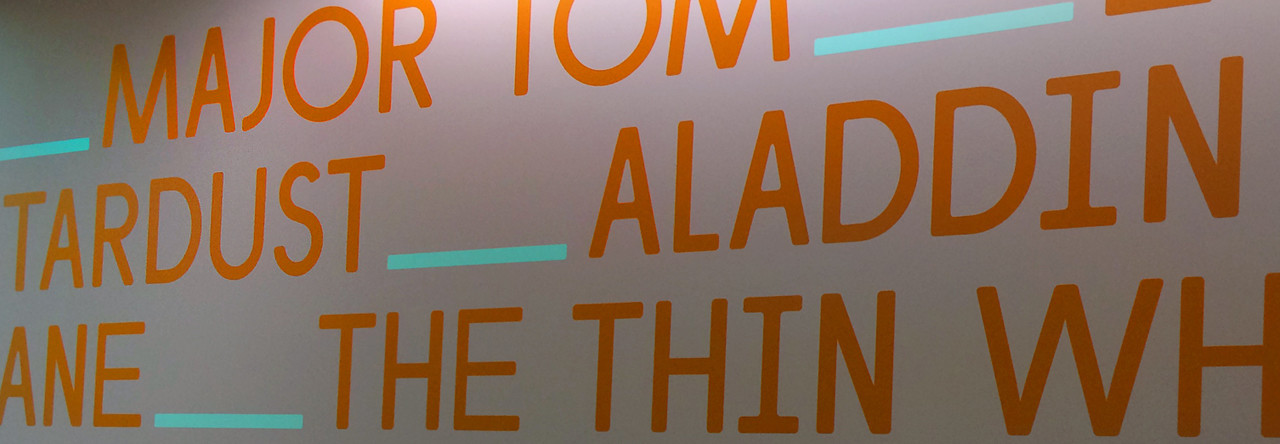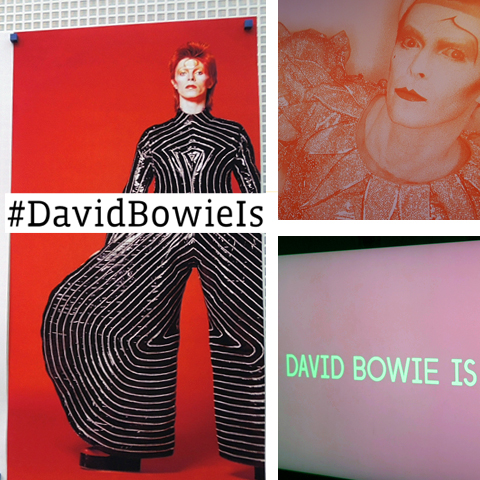It’s safe to say that we are all gutted by the untimely passing of David Bowie. Rather than write an obituary of some stripe (so many have been written, and so much more eloquently than I could ever do), I am posting my Bull Tongue Review #2 piece about Bowie’s many shape-shifts and refractions.
#DavidBowieIs
Museum of Contemporary Art, Chicago
Sep 23, 2014–Jan 4, 2015
One of the great joys of the #DavidBowieIs retrospective at Chicago’s Museum of Contemporary Arts is being able to follow his meteoric evolution from influenced to influencer, Mod to postmodern.
It’s easy to forget that David Bowie, icon, started as David Jones, ambitious kid.
Very early on, there’s a photo of him at age 16 looking thoroughly Mod: op-art tie, wide-wale corduroy suit, tidal-wave quiff.
But his artistic maturation happens quickly, and Bowie — like a shark — keeps moving forward.
Time — and personae — are fluid. The show’s asynchronous setup (the audio guide is cued by wireless signals) allows one to jump back and forth among (or play favorites with) major Bowie periods — from Hunky Dory to Diamond Dogs and the poignant Pierrot of “Ashes to Ashes.”
The presentation is cinematic. The walls are pitch black and the objects — from photographs and videos to instruments (like the synth Brian Eno used on “Heroes”), original costumes and Bowie’s own concept sketches — are backlit, allowing for one’s total immersion in #BowieWorld, a glam, amniotic (glamniotic?) fantasy universe where all manner of aesthetic input — Japanese avant-garde fashion, mime + mimicry, glitter + glam, punk + Kosmische, Cabaret + Tin Pan Alley — is synthesized and reframed, often to startling effect.
Bowie himself narrates, via cannily-curated audio snippets and numerous archival videos that add breadth and depth to the parade of iconic costumes (Ziggy Stardust’s quilted paisley jumpsuit; the Dada-inspired geometric tuxedo from SNL; the Alexander McQueen-designed Union Jack frock coat fromOutside) and rare videos.
At the start, he’s a working musician for London bands with goofy names, like the Kon-rads and the King Bees.
Turn the corner and he’s a Pre-Raphaelite folkie, enraging the middle class with his ambiguous sexuality and equally ambiguous tailoring.
The exhibit allows for total immersion in #BowieWorld, a glam, amniotic (glamniotic?) fantasy universe where all manner of aesthetic input — Japanese avant-garde fashion, mime + mimicry, glitter + glam, punk + Kosmische, Cabaret + Tin Pan Alley — is synthesized and reframed, often to startling effect.
Now he’s a Kabuki space alien. Another molt and he’s the intense, austere Cold War Bowie of the Berlin trilogy.
Finally, he’s an icon who’s comfortably settled into being (more or less) himself.
A friend once dismissed Bowie’s music by saying that it never made him cry. But songwriter-y confession has never been Bowie’s mode. He’s always been apart — an observer who distills and records. He constantly steps into roles, sliding a new mask into place.
The exhibit crew wear t-shirts that cheekily read, “#DavidBowieIs … here to help,” and it’s true: he’s like a socio-cultural guardian angel watching over all the misfits and outsiders.
And yet, the show stops just short of humanizing David Jones. The pace picks up drastically at the end, as though the curators collectively agreed that the less said about #DrumnBassBowie and #NormcoreBowie, the better. (Creative missteps are largely glossed over.)
And, while his tiny cocaine spoon is included as a reminder that he has human weaknesses, just like the rest of us, it (tellingly) does not reappear in the exhaustive exhibition catalogue — making #DavidBowieIs more hagiography than biography.
But why quibble, when the case for sainthood is so strong?


